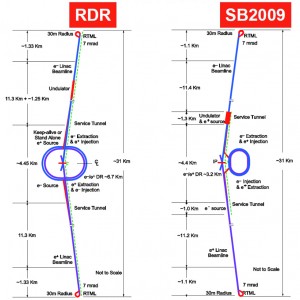Happy New Year! Today is a good time to take stock of what we achieved last year and reflect on our goals for the coming year. The primary goal for 2011 was to establish a new ILC baseline that would be better optimised for cost, performance and risk, as well as to carry out the high-priority enabling R&D to demonstrate that the key technical performance goals for an ILC are achievable. We have already come a long way towards reaching those goals. For 2012, our primary goal is to produce, by the end of the year, a Technical Design Report that is based on this solid foundation. A fair question to pose is, Where will that leave us?
We began proposing in autumn 2009 a set of changes to the baseline that would reduce costs and/or improve some areas of the design, a process led by our GDE project managers Marc Ross, Nick Walker and Akira Yamamoto. We subjected the larger parts of that proposal to a Top Level Change Control Process that was completed last spring with the approval of four major changes, including establishing operating conditions for the superconducting radiofrequency (SCRF) system:
- The average accelerating gradient for the installed superconducting cavities is 31.5 megavolts per metre as in the Reference Design Report, but the acceptable range of gradients will be +/- 20 percent.
- The baseline civil design was changed from a double- to a single-tunnel design for the linacs by removing the support equipment tunnel. This change also involves site-dependent variations in the tunnel configuration and in the high-power radiofrequency powering.
- A new beam parameter set has been adopted, having half the number of bunches in each bunch train, resulting in a reduction in beam power and enabling a reduction of the damping ring circumference from 6.4 to 3.2 kilometres. The idea is to use stronger focussing in the final focus to retain the design luminosity.
- The positron source was moved to the end of the linac, bringing it to the central campus and sharing tunnels with the beam delivery system. This change shortens the tunnel and makes a more coherent design in the central region.
We estimate that the set of top-level changes to the baseline will save about 10 percent in the total ILC construction costs as compared to the reference design. Our philosophy has simply been to pro-actively find such cost savings, without reducing scope or performance, in order to help compensate for the inevitable cost increases that have typically plagued very large projects as the design matures.
Following approval of the top-level baseline changes, we have been carrying out a set of system-by-system specialised workshops we call Baseline Technical Reviews, where we have dealt with the many smaller design issues and decisions for the Technical Design Report (TDR). So far, we have completed two of these reviews, one for the positron source and one for accelerator systems. We will conduct the final two reviews over the coming months, one on SCRF and one on conventional facilities. The rest of 2012 will involve a concerted effort to complete the TDR. Our plan is that the final report will be a self-contained document providing all the elements needed to propose the ILC to governments.
Although I did not write about our R&D achievements today, we also are on schedule to complete our major R&D demonstration goals for the TDR. These include achieving high gradient at high yield, demonstrating we can mitigate electron cloud effects in the positron damping ring and achieving and controlling small beam spots at the final focus. I will write more about each of these during the coming year.
As I posed at the beginning of today’s column, where will this leave us? We will have produced a solid design and costing for the ILC by the end of 2012 and the subsequent reviews and finalisation of the report should be completed by about mid-2013. Following our achieving this final major GDE milestone, we propose to continue to evolve the design, as well as pursue systems tests and R&D towards extending the energy reach. The project will be ready to be proposed when the physics case is established by the LHC and collaborating governments are receptive to considering a new large global initiative for the next-generation particle physics accelerator. We hope that will all fall in place not too long after we complete the TDR.





Recent Comments